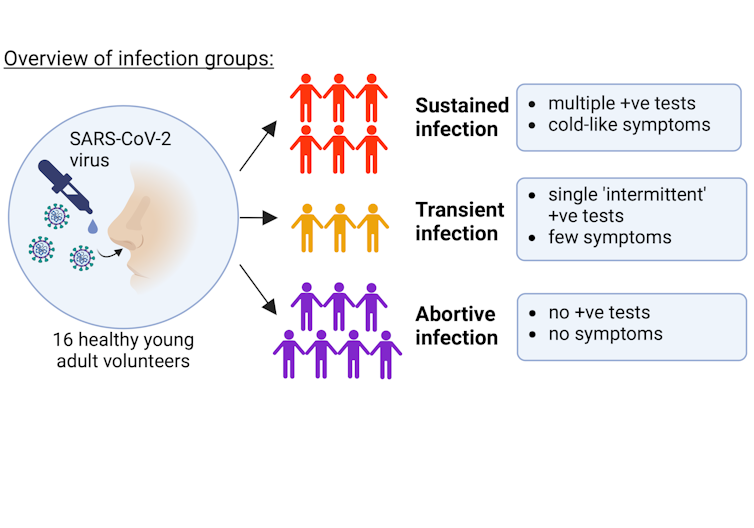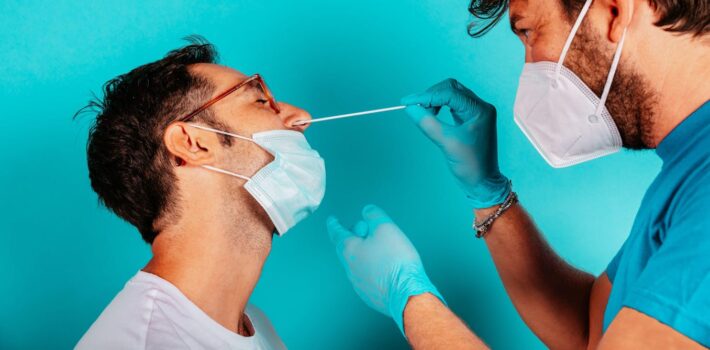All through the pandemic, one of many key questions on everybody’s thoughts was why some individuals prevented getting COVID, whereas others caught the virus a number of occasions.
By a collaboration between College School London, the Wellcome Sanger Institute and Imperial School London within the UK, we got down to reply this query utilizing the world’s first managed “challenge trial” for COVID – the place volunteers have been intentionally uncovered to SARS-CoV-2, the virus that causes COVID, in order that it may very well be studied in nice element.
Unvaccinated wholesome volunteers with no prior historical past of COVID have been uncovered – through a nasal spray – to an especially low dose of the unique pressure of SARS-CoV-2. The volunteers have been then intently monitored in a quarantine unit, with common checks and samples taken to check their response to the virus in a extremely managed and secure setting.
For our recent study, printed in Nature, we collected samples from tissue situated halfway between the nostril and the throat in addition to blood samples from 16 volunteers. These samples have been taken earlier than the contributors have been uncovered to the virus, to present us a baseline measurement, and afterwards at common intervals.
The samples have been then processed and analysed utilizing single-cell sequencing expertise, which allowed us to extract and sequence the genetic materials of particular person cells. Utilizing this cutting-edge expertise, we might monitor the evolution of the illness in unprecedented element, from pre-infection to restoration.
To our shock, we discovered that, regardless of all of the volunteers being rigorously uncovered to the very same dose of the virus in the identical method, not everybody ended up testing constructive for COVID.
Actually, we have been capable of divide the volunteers into three distinct an infection teams (see illustration). Six out of the 16 volunteers developed typical gentle COVID, testing constructive for a number of days with cold-like signs. We referred to this group because the “sustained an infection group”.

Kaylee B. Worlock., Creator offered. Created with Biorender.com (no reuse)
Out of the ten volunteers who didn’t develop a sustained an infection, suggesting that they have been capable of combat off the virus early on, three went on to develop an “intermediate” an infection with intermittent single constructive viral checks and restricted signs. We referred to as them the “transient an infection group”.
The ultimate seven volunteers remained destructive on testing and didn’t develop any signs. This was the “abortive an infection group”. That is the primary affirmation of abortive infections, which have been beforehand unproven. Regardless of variations in an infection outcomes, contributors in all teams shared some particular novel immune responses, together with in these whose immune programs prevented the an infection.
Once we in contrast the timings of the mobile response between the three an infection teams, we noticed distinct patterns. For instance, within the transiently contaminated volunteers the place the virus was solely briefly detected, we noticed a robust and quick accumulation of immune cells within the nostril in the future after an infection.
This contrasted with the sustained an infection group, the place a extra delayed response was seen, beginning 5 days after an infection and doubtlessly enabling the virus to take maintain in these volunteers.
In these individuals, we have been capable of determine cells stimulated by a key antiviral defence response in each the nostril and the blood. This response, referred to as the “interferon” response, is without doubt one of the methods our our bodies sign to our immune system to assist combat off viruses and different infections. We have been shocked to seek out that this response was detected within the blood earlier than it was detected within the nostril, suggesting that the immune response spreads from the nostril in a short time.
Protecting gene
Lastly, we recognized a selected gene referred to as HLA-DQA2, which was expressed (activated to supply a protein) at a a lot increased degree within the volunteers who didn’t go on to develop a sustained an infection and will therefore be used as a marker of safety. Due to this fact, we would have the ability to use this data and determine those that are in all probability going to be shielded from extreme COVID.
These findings assist us fill in some gaps in our information, portray a way more detailed image relating to how our our bodies react to a brand new virus, notably within the first couple of days of an an infection, which is essential.
We are able to use this data to check our information to different information we’re at the moment producing, particularly the place we’re “difficult” volunteers to different viruses and more moderen strains of COVID. In distinction to our present research, these will principally embrace volunteers who’ve been vaccinated or naturally contaminated – that’s, individuals who have already got immunity.
Our research has important implications for future therapies and vaccine growth. By evaluating our information to volunteers who’ve by no means been uncovered to the virus with those that have already got immunity, we might be able to determine new methods of inducing safety, whereas additionally serving to the event of more practical vaccines for future pandemics. In essence, our analysis is a step in direction of higher preparedness for the following pandemic.





